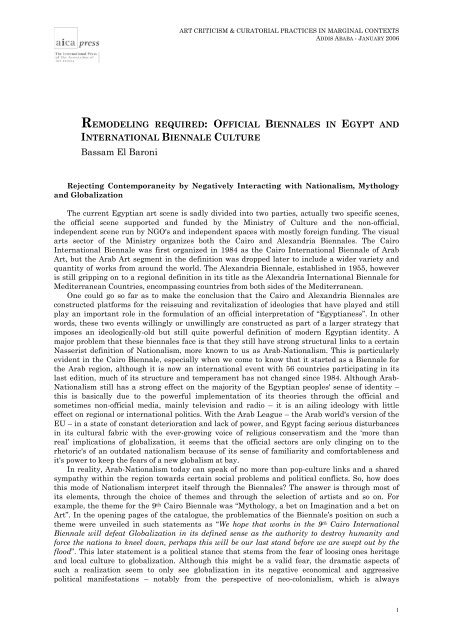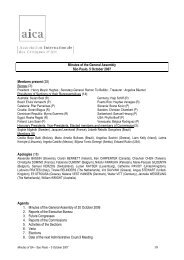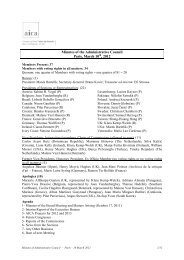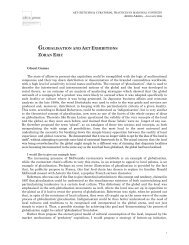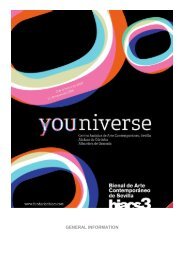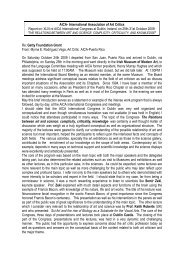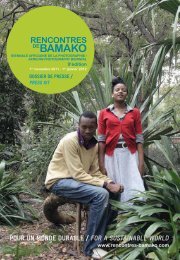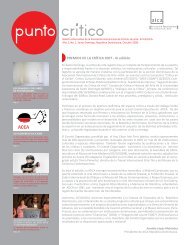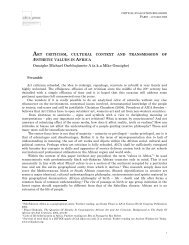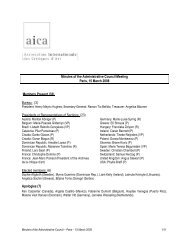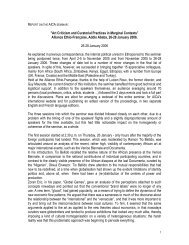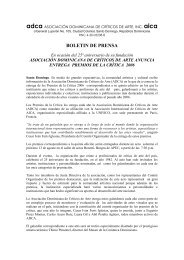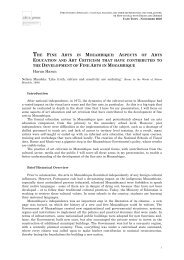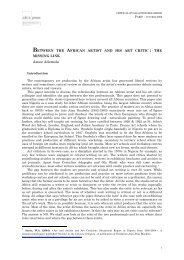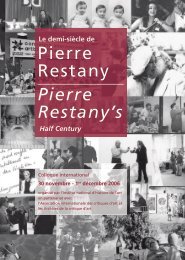Bassam EL-BARONI - Remodeling required - AICA international
Bassam EL-BARONI - Remodeling required - AICA international
Bassam EL-BARONI - Remodeling required - AICA international
Create successful ePaper yourself
Turn your PDF publications into a flip-book with our unique Google optimized e-Paper software.
ART CRITICISM & CURATORIAL PRACTICES IN MARGINAL CONTEXTS<br />
ADDIS ABABA - JANUARY 2006<br />
REMOD<strong>EL</strong>ING REQUIRED: OFFICIAL BIENNALES IN EGYPT AND<br />
INTERNATIONAL BIENNALE CULTURE<br />
<strong>Bassam</strong> El Baroni<br />
Rejecting Contemporaneity by Negatively Interacting with Nationalism, Mythology<br />
and Globalization<br />
The current Egyptian art scene is sadly divided into two parties, actually two specific scenes,<br />
the official scene supported and funded by the Ministry of Culture and the non-official,<br />
independent scene run by NGO's and independent spaces with mostly foreign funding. The visual<br />
arts sector of the Ministry organizes both the Cairo and Alexandria Biennales. The Cairo<br />
International Biennale was first organized in 1984 as the Cairo International Biennale of Arab<br />
Art, but the Arab Art segment in the definition was dropped later to include a wider variety and<br />
quantity of works from around the world. The Alexandria Biennale, established in 1955, however<br />
is still gripping on to a regional definition in its title as the Alexandria International Biennale for<br />
Mediterranean Countries, encompassing countries from both sides of the Mediterranean.<br />
One could go so far as to make the conclusion that the Cairo and Alexandria Biennales are<br />
constructed platforms for the reissuing and revitalization of ideologies that have played and still<br />
play an important role in the formulation of an official interpretation of “Egyptianess”. In other<br />
words, these two events willingly or unwillingly are constructed as part of a larger strategy that<br />
imposes an ideologically-old but still quite powerful definition of modern Egyptian identity. A<br />
major problem that these biennales face is that they still have strong structural links to a certain<br />
Nasserist definition of Nationalism, more known to us as Arab-Nationalism. This is particularly<br />
evident in the Cairo Biennale, especially when we come to know that it started as a Biennale for<br />
the Arab region, although it is now an <strong>international</strong> event with 56 countries participating in its<br />
last edition, much of its structure and temperament has not changed since 1984. Although Arab-<br />
Nationalism still has a strong effect on the majority of the Egyptian peoples' sense of identity –<br />
this is basically due to the powerful implementation of its theories through the official and<br />
sometimes non-official media, mainly television and radio – it is an ailing ideology with little<br />
effect on regional or <strong>international</strong> politics. With the Arab League – the Arab world's version of the<br />
EU – in a state of constant deterioration and lack of power, and Egypt facing serious disturbances<br />
in its cultural fabric with the ever-growing voice of religious conservatism and the ‘more than<br />
real’ implications of globalization, it seems that the official sectors are only clinging on to the<br />
rhetoric's of an outdated nationalism because of its sense of familiarity and comfortableness and<br />
it's power to keep the fears of a new globalism at bay.<br />
In reality, Arab-Nationalism today can speak of no more than pop-culture links and a shared<br />
sympathy within the region towards certain social problems and political conflicts. So, how does<br />
this mode of Nationalism interpret itself through the Biennales? The answer is through most of<br />
its elements, through the choice of themes and through the selection of artists and so on. For<br />
example, the theme for the 9 th Cairo Biennale was “Mythology, a bet on Imagination and a bet on<br />
Art”. In the opening pages of the catalogue, the problematics of the Biennale’s position on such a<br />
theme were unveiled in such statements as “We hope that works in the 9 th Cairo International<br />
Biennale will defeat Globalization in its defined sense as the authority to destroy humanity and<br />
force the nations to kneel down, perhaps this will be our last stand before we are swept out by the<br />
flood”. This later statement is a political stance that stems from the fear of loosing ones heritage<br />
and local culture to globalization. Although this might be a valid fear, the dramatic aspects of<br />
such a realization seem to only see globalization in its negative economical and aggressive<br />
political manifestations – notably from the perspective of neo-colonialism, which is always<br />
1
ART CRITICISM & CURATORIAL PRACTICES IN MARGINAL CONTEXTS<br />
ADDIS ABABA - JANUARY 2006<br />
symbolized in the form of American politics. But, coming into contact with globalism's dilemmas,<br />
tools, effects and banal manifestations, is a daily experience for most Egyptians as for most<br />
people in today's world. Today, there can no longer be a purely local culture and for that matter,<br />
by sensing the reality of our daily lives and touching upon historical facts, it is impossible to ever<br />
reach the conclusion that there ever will be a purely global culture.<br />
The official biennales of Egypt have become “Kitsch Biennales”, not just because most of the<br />
works they exhibit are of poor quality, but mainly because their structures are derivatives of old<br />
outmoded biennales or “Big International Exhibition” models. It is also apparent that this kitsch<br />
factor is the result of their usage of political, geographical and mythological histories that<br />
simulate the past but don't seriously negotiate with the present. Rather than structuring<br />
frameworks that deal with issues of identity and globalization, the Biennales address these<br />
complex issues through off-centered and imposed cultural-political outlooks that are<br />
nationalistically impulsive. The result is that the latent issues at hand are represented in an air<br />
of confusion and cultural misunderstanding. What complicates the structure even more is the<br />
haphazardness in the organization and selection process, which allows for a few examples of<br />
“progressiveness” to be exhibited alongside works that can hardly be linked stylistically or<br />
philosophically to the current status-quo of the arts in general. Instead of “conquering<br />
globalization”, the 9 th Cairo International Biennale caused a major commotion for most of the<br />
Egyptian audience in that, by far, the best work exhibited came from the American artist Paul<br />
Pfieffer.<br />
Pfieffer’s multi-screen video installation was the only curated presentation in the Biennale.<br />
Curated by Holly Block and Jane Farver, the installation was allotted the largest space for a<br />
single artist in the biennale, the lavish expenditure on the artist’s presentation was made<br />
possible through various grants from American foundations. The biennale’s organizing committee<br />
made an obvious political statement by awarding the installation a mere jury prize instead of the<br />
grand prize it rightfully deserved. The Cairo biennale always seems to somehow identify<br />
globalization as the main oppressor, it seems to function with the democratic tools of an Olympic<br />
sports event that favors <strong>international</strong>ism over globalism because the later might disrupt its<br />
system of reinforcing the past for fear of actually facing the present. The “past” one is referring to<br />
can be witnessed in the majority of works featured in the biennale. The mediocre majority of<br />
works that are various derivatives of abstract expressionism, cubism and other modernist<br />
vocabularies are selected on behalf of the biennale by the ministries of culture of the invited<br />
countries, with no apparent “quality control” practiced by the biennale’s organizers.<br />
History takes on an even more nostalgic turn when one investigates the mechanisms behind<br />
the Alexandria biennale. On taking a closer look at the biennale’s archives, it is quite evident that<br />
the biennale has had almost one theme since it first appeared in 1955. This theme with it’s<br />
multitude of poetically reconstructed clones is “Alexandria as a Cosmopolitan City through the<br />
Ages” or “The Shared Spirit of the Mediterranean as Embodied by Alexandria”. The latest version<br />
of the biennale, which happened to be its golden jubilee, opened in December 2005 under the title<br />
of Transparency of the universe, the Mediterranean spell. But what the biennale fails to see is that<br />
one cannot create strong and mutual contemporary cultural links with the “New Mediterranean”<br />
by enforcing a hackneyed reading of Alexandria’s cultural and historical legacies. It is easy to<br />
romanticize about the Alexandria of Lawrence Durrell’s Alexandria Quartet and to highlight its<br />
multicultural, multiethnic, and super cosmopolitan past. But what about the Alexandria of the<br />
21 st century, where and how do we position and recognize it geographically and philosophically?<br />
How do we negotiate it’s identity in the midst of today’s tumultuous cultural climate? The<br />
conflictual experiences of globalization and many other inflected phenomena are causing the<br />
ancient city to unsteadily exist in a state of constant flux. However, it seems that it is satisfactory<br />
enough for the Alexandria biennale in 2005 and 2006 to hold its seminars on topics such as<br />
“Greek Mythology” and “Leonardo Da Vinci”…<br />
© <strong>AICA</strong> Press et l’auteur<br />
2


